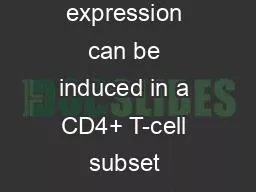

ORIGINAL RESEARCH PAPER Groh V Smythe K Dai Z Spies T Fas ligandmediated paracrine T cell regulation by the receptor NKG2D in tumor immunity Nature Immunol 28 May 2006 doi101038ni13 ID: 818666
Download Pdf The PPT/PDF document "NKG2D expression can be induced in a CD4..." is the property of its rightful owner. Permission is granted to download and print the materials on this web site for personal, non-commercial use only, and to display it on your personal computer provided you do not modify the materials and that you retain all copyright notices contained in the materials. By downloading content from our website, you accept the terms of this agreement.
NKG2D expression can be induced in a CD4
NKG2D expression can be induced in a CD4+ T-cell subset following stimulation of the T-cell-receptor complex (which results in T-cell activation). Co-stimulation of NKG2D+CD4+ T cells in the presence of MICA resulted in an increased number of NKG2D+CD4+ T cells, but ORIGINAL RESEARCH PAPER Groh, V., Smythe, K., Dai, Z. & Spies, T. Fas ligand-mediated paracrine T cell regulation by the receptor NKG2D in tumor immunity. Nature Immunol. 28 May 2006 (doi:10.1038/ni1350)Frye and Watt have identified a new RNA methyltransferase that is a direct target of MYC and contributes to tumorigenesis. MISU (MYC-induced SUN-domain-containing protein) is overexpressed in many human tumours, and its knockdown decreases proliferation and tumour growth in a xenograft model.The authors used microarrays to screen RNA isolated from skin cells of mice that express an inducible form of MYC. One mRNA that was strongly induced by MYC encoded an unknown protein, which homology indicated might be an RNA methyltransferase. This activity was confirmed biochemically, and expression studies showed that it is expressed in epidermal cells and other cell types. In G1 phase it is found at low levels, predominantly in the nucleoli, where it interacts with transcripts that have been produced by RNA polymerase III. By contrast, during S phase it is more highly expressed and is more evenly distributed in other parts of the nucleus. Chromatin immunoprecipitation confirmed that MISU is a direct target of MYC.RNA interference (RNAi) constructs against MISU were expressed in proliferating human keratinocytes. They caused a decrease in proliferation and inhibited MYC-induced differentiation. These effects, and the direct regulation by ORIGINAL RESEARCH PAPER Frye, M. & Watt, F. M. The RNA methyltransferase Misu (NSun2) mediates Myc-induced proliferation and is upregulated in tumors. Curr. Biol. 16, 971 981 (2006) TUMORIGENESISNew MYC targetRESEARCH HIGHLIGHTSNATURE REVIEWS | CANCER VOLUME 6 | JULY 2006 | 487© 2006 Nature Publishing Group 2006